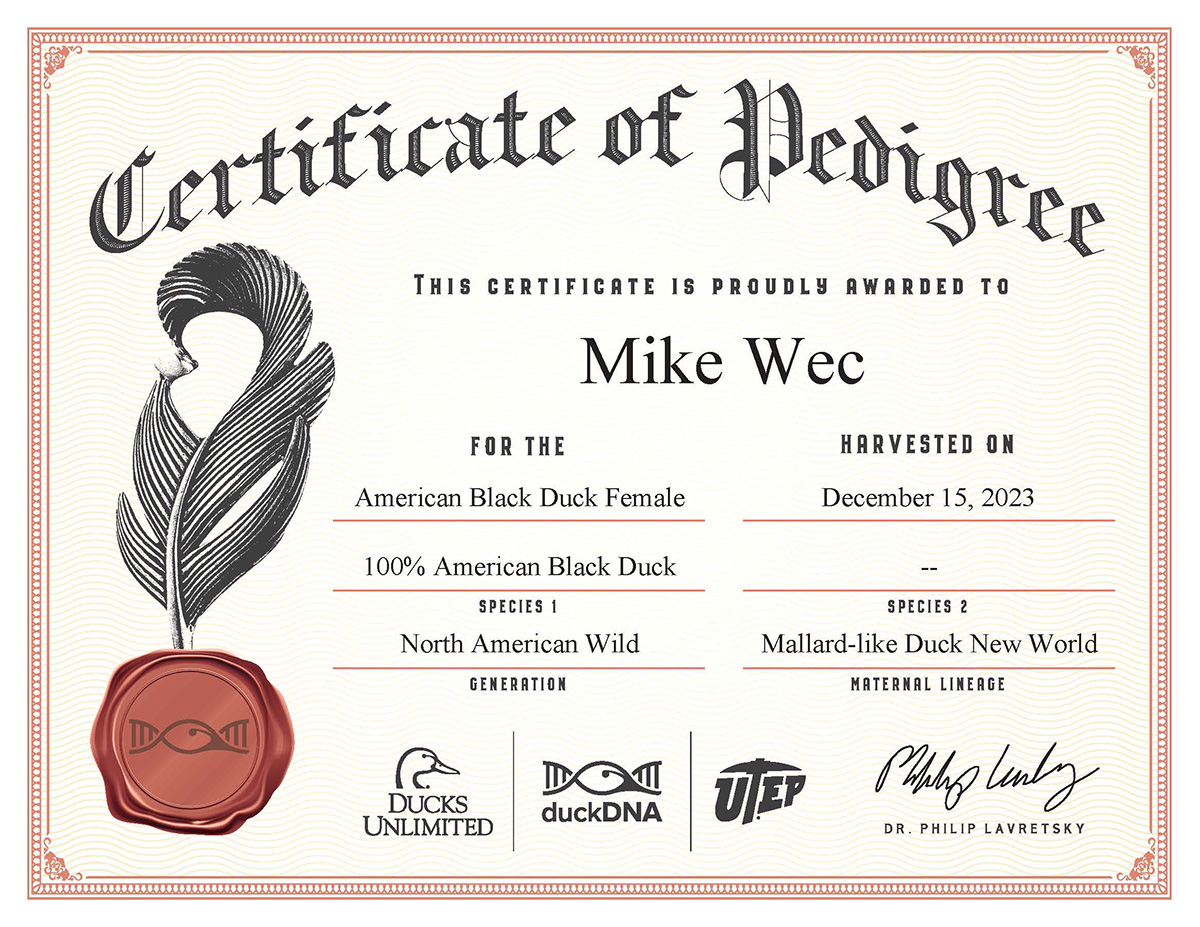The First Genetically Documented Leucistic American Black Duck
Ducks Unlimited and UTEP's new duckDNA project confirms the genetics of this waterfowl wonder
Ducks Unlimited and UTEP's new duckDNA project confirms the genetics of this waterfowl wonder
By Nathan Ratchford

On a chilly December morning with temperatures hovering around 30 degrees with a light breeze, hunter and Ducks Unlimited member Mike Wec set out for a hunt at one of his favorite local ponds in Massachusetts. The small cove he was trying to reach was covered with three-quarters of an inch of ice, which Wec had to break knee by knee with a sled and kayak in tow to reach open water to paddle in.
He arrived at his spot minutes before shooting light, sweating. The action started quickly. Wec spotted ducks in the distance. A few basic quacks from his call brought three his way. He used his favorite Slayer DUBAR Double Reed to give a greeting call and soon one duck was committed on his left wing. One shot rang out. In the low light, Wec thought he had downed a hen mallard due to its silhouette and white feathers under its setting wings, but it wasn't until he retrieved the duck in the icy water that he realized it was something significant. It was leucistic, with white and blonde feathers of varying shades. Wec couldn't believe his eyes and with this special duck in hand, his excitement rose along with the orange hues of the rising sun.
"I remember thinking it had to be a leucistic mallard or game-farm mallard," Wec said.
Leucism is a condition of unusual coloration in animals, and it is often confused with albinism. It is an inherited trait that results in the partial loss of pigmentation. In birds it produces all white plumage or just a few white feathers. Unlike albino birds, leucistic birds typically have dark eyes and normal vision.
The morning continued with more success as Wec additionally shot a black duck, a drake mallard, a wood duck and finally a banded drake mallard.

Curious about the blonde duck's genetic makeup, Wec's wife discovered Ducks Unlimited (DU) and the University of Texas at El Paso's (UTEP) duckDNA project after a quick Google search. The process was straightforward, with duckDNA providing a vial for a tissue sample and an app for submission.
Wec received the results this spring, revealing the surprise that the duck was a 100 percent pure American black duck female—the first genetically documented leucistic individual of its species. Previously, birds with similar appearances were often assumed to be leucistic mallards or domestic hybrids. Even scientists could only offer speculation without formal genetic analysis.
Dr. Phil Lavretsky, leading the duckDNA program at UTEP, remarked on the significance of this discovery: "This is a huge showcase of what duckDNA provides both to hunters and scientists in cooperation together at a level we've never had before. No more assumptions and biases—there is no hiding DNA."
DU Senior Waterfowl Scientist Dr. Mike Brasher echoed these sentiments: "As a hunter and duckDNA participant myself, it's really cool to deliver these truly unique results to people who care so deeply about this resource. And regarding this leucistic black duck—if it wasn't for duckDNA, we would never know what it was. Nobody else is providing this service and we're thrilled to continue it for the 2024–2025 season."
To discover more about the results from the project's first year and how you can get involved next year, visit duckdna.com.
Want to reach Mike Wec for further comments? @wicked_wec

The duckDNA project is a new citizen science initiative launched by Ducks Unlimited and the University of Texas at El Paso. In its pilot year, DU selected 309 hunters to collect a tissue sample from harvested ducks for genetic analysis and learned several new things about waterfowl genetics. To learn more about the project, visit duckdna.com.
Data collected through this project, including a broader understanding of the presence of game-farm mallard genes in wild mallard populations, will help researchers and waterfowl managers uncover the influence of genetics on waterfowl population dynamics and behavior, while enabling more informed decisions to benefit North American waterfowl.
Media Contact:
Nathan Ratchford
Conservation Communications Coordinator
nratchford@ducks.org
Ducks Unlimited uses cookies to enhance your browsing experience, optimize site functionality, analyze traffic, and deliver personalized advertising through third parties. By continuing to use this site, you agree to our use of cookies. View Privacy Policy